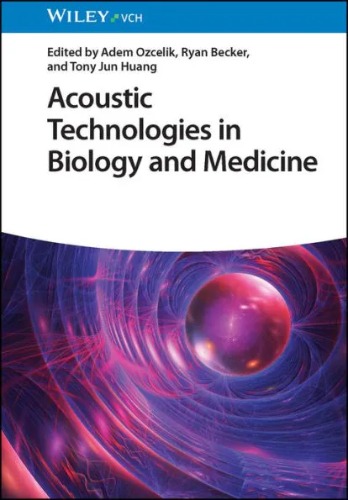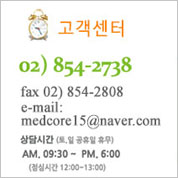상품상세정보
의학서적전문 "성보의학서적"의 신간의학도서입니다.Acoustic Technologies in Biology and Medicine
Complete, balanced resource encompassing all required technical, theoretical, and applied multidisciplinary knowledge related to acoustics
Taking a multidisciplinary approach involving fluid mechanics, physics, chemistry, electronics, and the life sciences to provide a unified and competent overview of the field, Acoustic Technologies in Biology and Medicine covers the fundamental principles of acoustic wave generation and propagation, different acoustic systems and technologies with the interplay of physical forces, theoretical foundations, and the state-of-the-art biomedical applications of acoustics.
State-of-the-art applications of acoustics in biology and medicine are presented, including single cell and organism manipulation, acoustic biosensing, cancer cell isolation (liquid biopsy), cell/tissue stimulation and ablation, micro-robot actuation, acoustic imaging, and drug delivery.
Contributed to and edited by highly qualified professionals with significant experience in the field, Acoustic Technologies in Biology and Medicine covers sample topics such as:
Materials for acoustic wave generation and modulation, ultrasound imaging, and photoacoustic imaging and sensing for biomedical applications
Therapeutic ultrasound, application of ultrasound responsive reagents for drug delivery systems, and acoustic levitation and acoustic holograms
Application of ultrasonic waves in bioparticle manipulation and separation, acoustic biosensors, and acoustic micro and nanorobots in medicine
Different technologies of acoustic systems, including bulk and surface acoustic wave-based platforms, acoustic imaging, acoustic sensors, and acoustic levitators
A cornerstone reference bridging the gap between rapidly advancing acoustic technologies with state-of-the-art applications in biology and medicine, Acoustic Technologies in Biology and Medicine is an essential resource on the subject for biophysicists, materials scientists, biotechnologists, bioengineers, sensor developers, electronics engineers, and all professionals in the greater biotechnological industry.
-도서목차-Preface xv
1 Fundamentals of Acoustic Wave Generation and Propagation 1
Mehmet A. Sahin, Mushtaq Ali, Jinsoo Park, and Ghulam Destgeer
1.1 Introduction 1
1.1.1 Acoustic or Sound Waves 1
1.1.2 Dominos Effect 1
1.1.3 Elastic vs Inelastic Waves 2
1.1.4 Scope of Acoustics 4
1.2 Brief History of Acoustic Waves 4
1.2.1 Early History 4
1.2.2 History of Acoustic Streaming 4
1.2.3 History of Acoustic Radiation Force 5
1.3 What Is an Acoustic Wave? 6
1.3.1 Acoustic Parameters 6
1.3.2 Displacement, Velocity, and Pressure Fields 6
1.3.3 Wave Propagation 7
1.3.4 Wave Dissipation 7
1.3.5 Wave Dispersion 8
1.4 Modes of Acoustic Waves 8
1.4.1 Categorization Based on Frequency Range 9
1.4.2 Categorization Based on Propagation Mode 9
1.4.2.1 Longitudinal Waves 9
1.4.2.2 Shear Waves 10
1.4.2.3 Rayleigh Waves 11
1.4.2.4 Love Waves 12
1.4.2.5 Lamb Waves 12
1.4.3 Categorization Based on Wave Configuration 12
1.4.3.1 Traveling Waves 12
1.4.3.2 Standing Waves 13
1.5 Acoustic Wave Propagation and Interaction 13
1.5.1 Transmission and Reflection of Acoustic Waves 13
1.5.2 Acoustic Scattering 14
1.5.3 Acoustic Radiation 16
1.6 Acoustic Wave Attenuation 18
1.6.1 Viscoelastic Attenuation 18
1.6.2 Acousto-Thermal Heating 19
1.6.3 Acoustic Streaming Flow 19
1.6.3.1 Eckart Streaming 20
1.6.3.2 Rayleigh Streaming 20
1.6.3.3 Bubble-Driven Microstreaming 21
1.6.3.4 Applications of Acoustic Streaming Flow 21
1.7 Generation and Propagation of Acoustic Waves 22
1.7.1 Acoustic Waves Generation in Nature 22
1.7.2 Generation of Acoustic Waves in Lab 22
1.7.2.1 Lower-Frequency Acoustic Waves 22
1.7.2.2 Piezoelectricity and High-Frequency Wave Generation 23
1.8 Acoustic Waves Effects in Fluidic Media 24
1.8.1 Vibrating Membranes and Sharp-Edge Structures 25
1.8.2 Oscillating Bubbles 25
1.8.2.1 Cavitation 26
1.8.3 Optoacoustic Imaging 27
1.8.4 Manifestations of Acoustic Radiation Force and Acoustic Streaming Flow 28
List of Abbreviations and Symbols 28
References 29
2 Basic Theories and Physics of Acoustic Technologies 37
Khemraj G. Kshetri and Nitesh Nama
2.1 Introduction 37
2.2 Acoustic Waves in Solids 38
2.2.1 Governing Equation 39
2.2.2 Acoustic Waves in Non-piezoelectric Solids 39
2.2.3 Acoustic Waves in Piezoelectric Solids 40
2.3 Acoustic Waves in Fluids 40
2.3.1 Governing Equations 40
2.3.2 Acoustic Streaming 41
2.3.2.1 Modeling Approach for Slow Streaming 44
2.3.2.2 Modeling Approach for Fast Streaming 45
2.3.3 Distinction Between Lagrangian and Eulerian Fluid Velocity and Stokes’ Drift 46
2.3.4 Acoustic Streaming Near Solid Particles 47
2.3.5 Acoustic Streaming Near Fluid–Fluid Interfaces 47
2.4 Forces in Acoustofluidic Systems 49
2.4.1 Primary Acoustic Radiation Force 49
2.4.2 Secondary Acoustic Radiation Force 52
2.4.2.1 Forces Between Two Rigid Spheres 53
2.4.2.2 Forces Between Two Bubbles 53
2.4.2.3 Forces Between a Solid Particle and a Bubble 54
2.4.2.4 Forces Between a Liquid Drop and a Bubble 55
2.4.3 Hydrodynamic Drag Force 55
2.5 Conclusions and Perspectives 57
References 58
3 Materials for Acoustic Wave Generation and Modulation 67
Noé Jiménez
3.1 Introduction 67
3.1.1 Generation and Detection of Ultrasound 67
3.1.2 Technologies for Ultrasound Transducers 68
3.2 Piezoelectricity 68
3.2.1 Model Equations 68
3.2.1.1 Stress-Charge Formulation 69
3.2.1.2 Strain-Charge Formulation 70
3.2.1.3 Stress-Field Formulation 70
3.2.1.4 Strain-Field Formulation 70
3.2.2 The Piezoelectric Constants 70
3.2.3 Longitudinal Motion in a Piezoelectric Material 71
3.2.3.1 A Simple Piezoelectric Model 71
3.2.3.2 Waves in the Piezoelectric Material 72
3.3 Piezoelectric Materials 73
3.3.1 Piezoelectric Crystals 73
3.3.2 Piezoelectric Ceramics 74
3.3.3 Piezoelectric Polymers 74
3.3.4 Piezoelectric Composites 74
3.4 Ultrasound Transducers 75
3.4.1 Elements of a Transducer 75
3.4.2 The Piezoelectric Slab 75
3.4.3 Matching Layers 76
3.4.3.1 Classical Matching Layer Design 76
3.4.3.2 Multiple Matching Layer Design 77
3.4.3.3 Broadband Matching Layer Design 77
3.4.4 Backing Layer 77
3.4.5 Electrical Impedance Matching Network 78
3.5 Ultrasound Beams 78
3.5.1 Circular Aperture Transducers 78
3.5.2 Focused Transducers 80
3.5.3 Phased-Array Transducers 83
3.6 Acoustic Lenses 83
3.6.1 Refraction by Bulky Lenses 84
3.6.1.1 Spherical Lenses 84
3.6.1.2 Ellipsoidal Lenses 85
3.6.1.3 Axicon Lenses 85
3.6.1.4 Frensel and Fraxicon Lenses 86
3.6.1.5 Lenses for Vortex Generation 86
3.6.2 Diffraction by Gratings 87
3.6.2.1 Cartesian Diffraction Grating 87
3.6.2.2 Asymmetric Diffraction Grating 87
3.6.2.3 Fresnel Zone Plates 88
3.6.2.4 Archimedean Spiral Gratings 89
3.6.2.5 Fresnel-Spiral Zone Plate 90
3.6.3 Reflection by Curved Surfaces 90
3.6.3.1 Parabolic Reflectors 91
3.6.3.2 Ellipsoidal Reflectors 91
3.6.4 Holograms 91
3.6.4.1 Field Projections 91
3.6.4.2 Synthesis of Acoustic Images 93
3.6.4.3 Biomedical Applications of Holograms 94
References 95
4 Ultrasound and Ultrasonic Imaging in Medicine: Recent Advances 99
Tuğba Ö. Onur
4.1 Introduction 99
4.2 Ultrasound Waves 99
4.2.1 Types of Ultrasonic Waves 100
4.2.2 Behavior of Ultrasound Waves at Interfaces 100
4.2.3 Ultrasound Power and Intensity 101
4.2.4 Ultrasound Applications 102
4.3 Ultrasonic Imaging 103
4.3.1 Ultrasonic Imaging System 106
4.3.1.1 Transducer 106
4.3.1.2 Probes 107
4.3.1.3 Central Processing Unit 109
4.3.1.4 Output Display 109
4.3.2 Focus 109
4.3.3 Resolution 109
4.3.4 Beamforming 110
4.4 Sound-Tissue Interactions in Ultrasonography 110
4.4.1 Reflection 110
4.4.2 Refraction 111
4.4.3 Absorption 112
4.4.4 Attenuation 112
4.4.4.1 Attenuation by Reflection, Refraction, and Deflection 112
4.4.4.2 Attenuation by Scattering 113
4.4.4.3 Attenuation by Absorption 113
4.4.4.4 Time Gain Reduction (TGR) and Depth Gain Reduction (DGR) 114
4.5 Ultrasonic Imaging Methods 114
4.5.1 Real-Time Imaging 114
4.5.1.1 A-Mode 115
4.5.1.2 M-Mode 116
4.5.1.3 B-Mode 117
4.5.2 Doppler Ultrasonography 118
4.5.2.1 Continuous Wave Doppler 119
4.5.2.2 Duplex Doppler 119
4.5.2.3 Color Doppler 119
4.5.3 Real-Time Artifacts in Imaging 119
4.5.4 Factors Affecting Image Quality 120
4.6 Tissue Harmonic Imaging (THI) 121
4.6.1 The Occurrence of Harmonic Signals 121
4.6.2 The Separation of Harmonic Signals from the Main Signal 122
4.6.3 The Advantages of Harmonic Signals 122
4.7 Recent Advances in Ultrasound Imaging for Medicine 122
References 123
5 Photoacoustic Imaging and Sensing for Biomedical Applications 127
Amalina B. E. Attia, Ruochong Zhang, Mohesh Moothanchery, and Malini Olivo
5.1 Introduction 127
5.2 Photoacoustic Imaging Applications 130
5.2.1 PAI of Breast Cancer 130
5.2.1.1 In Vivo Imaging 130
5.2.1.2 Ex Vivo Imaging 132
5.2.2 PAI for Skin Imaging 133
5.2.2.1 PAI of Skin Cancer 135
5.2.2.2 PAI of Inflammatory Skin Diseases 137
5.2.2.3 PAI of Wounds 137
5.3 Photoacoustic Sensing for Biomedical Applications 139
5.3.1 Noninvasive Temperature Monitoring in Deep Tissue 139
5.3.2 Noninvasive Glucose Sensing 142
References 148
6 Therapeutic Ultrasound 159
Bar Glickstein, Hila Shinar, and Tali Ilovitsh
6.1 Introduction 159
6.2 Ultrasound-Induced Bioeffects 160
6.2.1 Introduction 160
6.2.2 Thermal Effects 160
6.2.3 Mechanical Effects 161
6.2.3.1 Cavitation 161
6.2.4 Contrast-Enhanced Effects 161
6.2.4.1 Microbubbles 161
6.2.4.2 Nanobubbles 162
6.2.4.3 Nanodroplets 162
6.2.5 Safety and Regulations 163
6.3 Therapeutic Ultrasound Applications 164
6.3.1 High-Intensity Focused Ultrasound 164
6.3.2 Histotripsy 166
6.3.3 Shock Wave Lithotripsy 169
6.3.4 Drug Delivery and Gene Therapy 170
6.3.5 Blood–Brain Barrier Opening 171
6.3.6 Low-Intensity Ultrasound for Neuromodulation 172
6.3.7 Bone Healing 172
6.3.8 Sonothrombolysis 172
6.3.9 Other Applications 173
6.4 Conclusions 173
References 174
7 Application of Ultrasound-Responsive Reagents for Drug Delivery Systems 181
Hiroshi Kida and Katsuro Tachibana
7.1 Historical Background of Research on Bubble Reagents for Medicine 181
7.2 Use of Bubble Reagents as Drug Delivery Systems 182
7.2.1 Acoustic Cavitation 182
7.2.2 Importance of Inertial and Non-inertial Cavitation in Improving Drug Permeability 184
7.2.3 Targeting and Focusing Using Acoustic Means 186
7.3 Variation of Ultrasound-Responsive Reagents for DDS 186
7.3.1 Shell Composition 186
7.3.2 Improved Stability by Polyethylene Glycol (PEG) Modification 187
7.3.3 Modification with Targeting Ligands 188
7.3.4 Drug and Gene Loading 188
7.3.5 Extended Adaptation of Ultrasound-Responsive Reagents 190
7.4 Research on Treatment of Diseases Using Ultrasonic Drug Delivery 192
7.4.1 Cancer 192
7.4.2 Central Nervous System Diseases 195
7.5 Conclusion 197
References 198
8 Acoustic Levitation and Acoustic Holograms 217
Tatsuki Fushimi and Yoichi Ochiai
8.1 Introduction 217
8.1.1 History of Acoustic Levitation 217
8.1.1.1 Classical Acoustic Levitator 218
8.1.1.2 Phased Array Levitator (PAL) 221
8.2 Acoustic Holograms 224
8.3 Numerical Simulation of Acoustic Levitator 227
8.3.1 Pressure Field Calculation 227
8.3.1.1 Huygens’ Approach 227
8.3.1.2 Spherical Harmonics Expansion 228
8.3.1.3 Angular Spectrum Method 229
8.3.2 Acoustic Radiation Force 230
8.3.2.1 Gor’kov 230
8.3.2.2 Spherical Harmonic Approach 231
8.4 Acoustic Hologram Optimization 231
8.4.1 Optimization Example with Diff-PAT 233
8.5 Applications in Biology and Medicine 234
8.5.1 Specimen Holding 234
8.5.2 Experiment Automation 234
8.5.3 3D Display 235
8.6 Conclusion and Future Remarks 236
Acknowledgments 237
References 237
9 Application of Ultrasonic Waves in Bioparticle Manipulation and Separation 243
M. Bülent Özer and Barbaros çetin
9.1 Introduction 243
9.2 Bioparticle Manipulation 244
9.2.1 Hydrodynamic Bioparticle Manipulation 244
9.2.2 Immunological (Antigen–Antibody Reaction) Bioparticle Manipulation 245
9.2.3 Electrokinetic Bioparticle Manipulation 245
9.2.4 Magnetophoretic Bioparticle Manipulation 245
9.2.5 Acoustophoretic Bioparticle Manipulation 246
9.2.6 Unification of Field Manipulation Methods 246
9.2.7 Comparison of Bioparticle Manipulation Methods 248
9.3 General Architecture of Acoustofluidic Devices 249
9.3.1 BAW Device Architecture 249
9.3.1.1 Piezoelectric Actuator 249
9.3.1.2 Chip Material 250
9.3.1.3 Lid Material 251
9.3.1.4 Device Assembly and Critical Dimensions 251
9.3.2 SAW Device Architecture 252
9.3.2.1 Piezoelectric Actuator 252
9.3.2.2 Interdigital Electrodes (IDT) 253
9.3.2.3 Microfluidic Chamber 254
9.3.2.4 Device Assembly and Critical Dimensions 254
9.3.3 Comparison of BAW and SAW Devices 254
9.4 Governing Equations in Acoustic Bioparticle Manipulation 255
9.4.1 First-Order Acoustic Field Variables 255
9.4.2 Second-Order Acoustic Field Variables 257
9.4.3 Acoustic Radiation Force on a Particle 258
9.4.4 Acoustic Radiation Force on a Particle Considering the Effect of Chip Material 260
9.5 Simulation of Acoustophoretic Bio-Particle Manipulation 264
9.5.1 Simulation of Piezoelectric Actuators 264
9.5.2 Numerical Simulations of the Elastic Material Surrounding the Channel 265
9.5.3 Simulation of Fluid Flow 266
9.5.4 Simulation of Particle Motion 267
9.6 Acoustofluidic Devices in Biological and Medical Applications 269
9.6.1 Applications Regarding Lipid Particles 269
9.6.2 Applications Regarding Cell Wash 278
9.6.3 Applications Regarding Separation of Blood Components 279
9.6.3.1 Plasma Separation 279
9.6.3.2 Platelet Separation 279
9.6.3.3 Separation of WBCs 280
9.6.4 Applications Regarding Cancer Cells 281
9.6.5 Applications Regarding Miscellaneous Cells 282
9.6.6 Application Regarding Bacteria 284
9.6.7 Applications Regarding Nanoscale (Bio)Particles 287
9.6.8 Miscellaneous Applications 289
9.7 Commercial and Regulatory Considerations for Acoustofluidic Devices 290
9.7.1 Cost 291
9.7.2 High Volume Manufacturing 292
9.7.3 Sterilization 292
9.7.4 Biocompatibility 294
9.7.5 Storage and Transportation Requirements 294
9.8 Summary and Outlook 294
References 296
10 Acoustic Biosensors 305
Alper Şi¸sman, Paddy French, Ay¸se Ogan, Erdal Korkmaz, Abbas A. Husseini, Ali M. Yazdani, and Johan Meyer
10.1 Introduction 305
10.1.1 Bulk Acoustic Wave (BAW) Mode 305
10.1.2 Surface Guided Acoustic Wave (SGAW) Modes 307
10.2 Biochemical Fundamentals of Sensing 310
10.2.1 Immobilization Strategies of Detection Element 311
10.2.1.1 Noncovalent Immobilization 311
10.2.1.2 Covalent Immobilization 312
10.2.1.3 Bioaffinity Bindings 313
10.3 Bulk Acoustic Wave Biosensors 314
10.3.1 Quartz Microbalance (QMB) Crystal Biosensors 315
10.3.2 Film Bulk Acoustic Wave (FBAR) Biosensors 316
10.4 Surface Transverse Wave Biosensors 317
10.4.1 SH-Wave and Love Wave Biosensors 317
10.4.2 Lamb Waves Biosensors 321
10.4.3 Rayleigh Wave Biosensors 324
10.4.4 Crystal Cuts and Axis Orientation 325
10.5 Commercial Biosensors and Trends 327
10.6 Conclusion 331
References 332
11 Acoustic Micro/Nanorobots in Medicine 343
Murat Kaynak, Amit Dolev, and Mahmut S. Sakar
11.1 Introduction 343
11.2 Theoretical Background 345
11.2.1 Introduction to Acoustics 345
11.2.2 Time-Averaged Acoustically Induced Forces 348
11.2.2.1 Primary Radiation Forces 348
11.2.2.2 Secondary Radiation Forces 351
11.2.2.3 Drag and Thrust-Induced Acoustic Streaming 354
11.3 Acoustic Micromanipulation Techniques 355
11.3.1 Introduction to Acoustic Tweezers 356
11.3.2 Acoustic Micromanipulation Using Bulk Acoustic Waves 357
11.4 Micro/Nanorobotic Devices Actuated by Acoustic Fields 361
11.4.1 Mobile Acoustic Micromachines 361
11.4.2 Soft Robotic Microsystems 363
11.5 In Vivo Actuation of Micro/Nanorobotic Devices 365
11.6 Discussion and Outlook 367
Acknowledgment 368
References 368
Index 375
기타 신간의학서적과 의학도서에 관련된 문의사항은 고객센터(02-854-2738) 또는 저희 성보의학서적 홈페이지내 도서문의 게시판에 문의바랍니다.
감사합니다.
성보의학서적 "http://www.medcore.kr






























